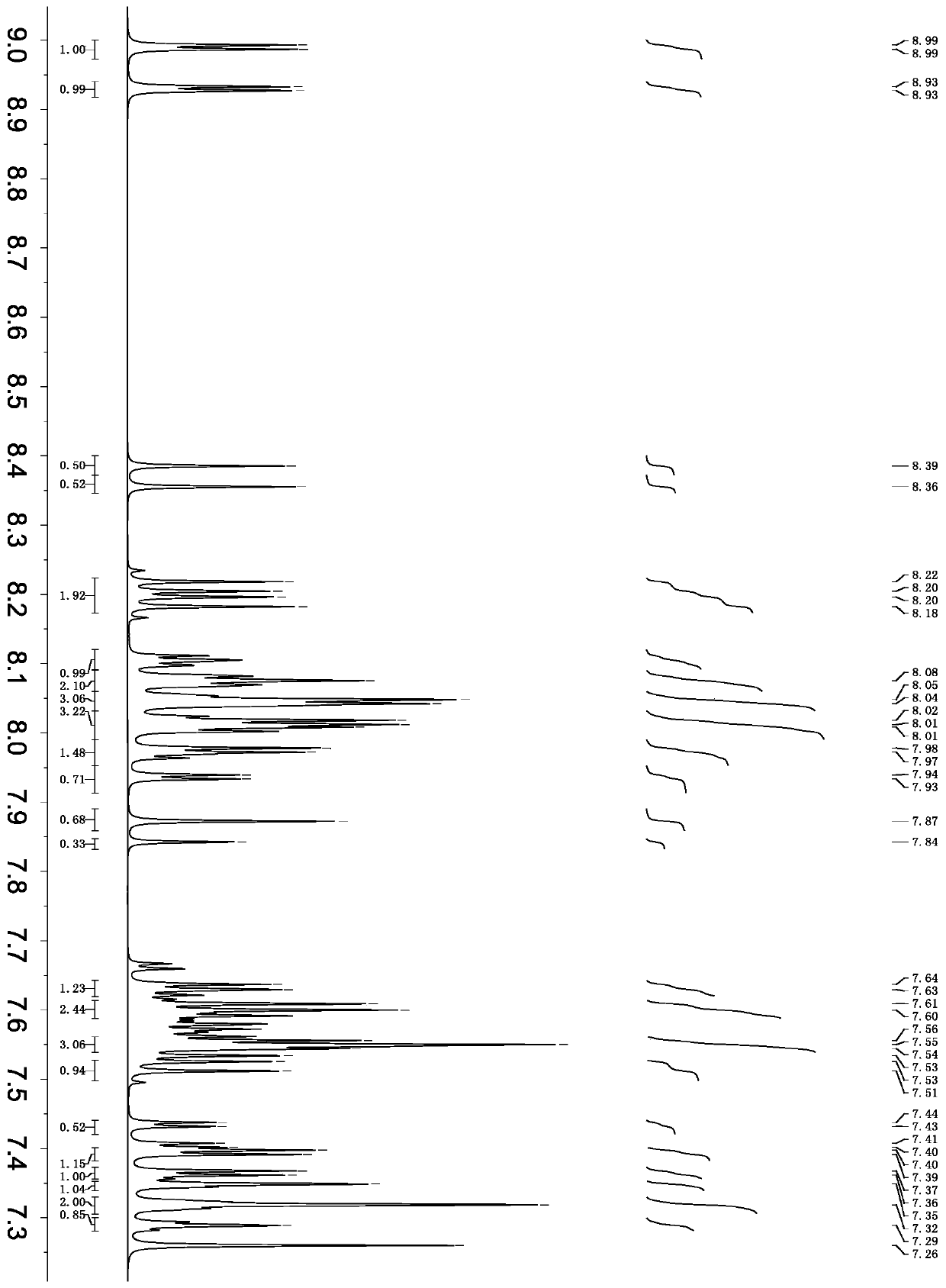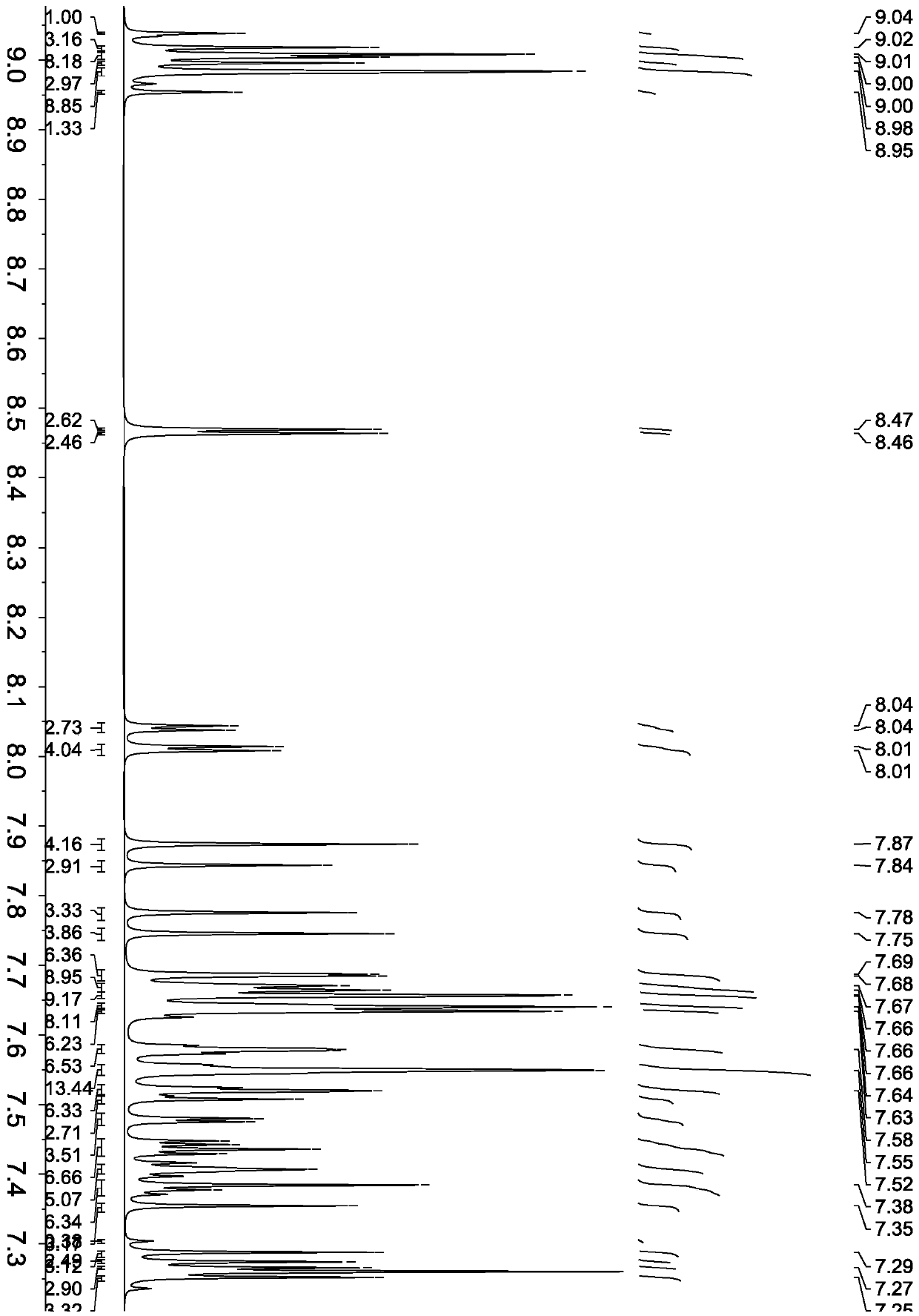Polycyclic aromatic hydrocarbon derivatives containing quinoxaline groups and application thereof
A technology of quinoxaline group and fused ring aromatic hydrocarbons, which is applied in the direction of electrical components, circuits, organic chemistry, etc., can solve the problems of increasing the complexity of the device manufacturing process, reducing the cost of OLEDs, disadvantages, etc., and achieve good electronic acceptance, good The effect of electromobility
- Summary
- Abstract
- Description
- Claims
- Application Information
AI Technical Summary
Problems solved by technology
Method used
Image
Examples
Embodiment 1
[0073] The synthesis of various quinoxaline boronic acid derivative intermediates of embodiment 1
[0074] Synthesis of 1,6-bromo-2,3-diphenylquinoxaline
[0075]
[0076] Add 3.91 grams of 4-bromo-o-phenylenediamine (molecular weight 186, 0.021 mol), 4.41 grams of diphenyl ketone (molecular weight 210, 0.021 mol), ethanol (40 ml), and stir for 3 minutes in a 250 ml three-necked flask. Add 0.2 g of concentrated sulfuric acid dropwise, and react at 65°C for 4 hours. After the reaction, cool to room temperature, filter, and wash with 50 ml of ethanol and 50 ml of petroleum ether in turn to obtain the intermediate compound 6-bromo-2,3-diphenyl 6.66 grams of quinoxaline (molecular weight: 360), yield 88.1%.
[0077] Synthesis of 2,7-bromo-1,2,3,4-tetrahydrophenazine
[0078]
[0079] The reaction steps are the same as the synthesis of 6-bromo-2,3-diphenylquinoxaline, except that diphenylethanedione is replaced by 1,2-cyclohexanedione to obtain the intermediate 7-bromo-1,2 ...
Embodiment 2
[0093] Synthesis of compound shown in formula (12)
[0094]
[0095] 1000ml three-neck flask equipped with magnetic stirring and nitrogen protection, add 4.72g of 6-bromo-2,3-dimethylquinoxaline (molecular weight 236, 0.02mol), 9,10-di(naphthalene-2-yl)anthracene -2-boronic acid 11.0g (molecular weight 474, 0.022mol), tetrakis ((triphenylphosphine) palladium 1.16g (molecular weight 1154, 0.001mol), 2M sodium carbonate aqueous solution 80ml, toluene 80ml, ethanol 80ml. Argon displacement Afterwards, reflux, monitor reaction with thin-layer chromatography (TLC) method, after 4 hours, TLC finds that raw material bromide reaction is complete, only product point.Cool down to 25 ℃, separate organic layer, evaporate to dryness, column chromatographic separation, ethyl acetate / petroleum ether to obtain 11.7 g of the compound represented by formula (12), with a molecular weight of 586 and a yield of 87.4%.
[0096] Product MS (m / e): 586, elemental analysis (C 44 h 30 N 2 ): the...
Embodiment 3
[0098] Synthesis of compound shown in formula (13)
[0099] The synthesis steps are the same as in Example 2, except that 6-bromo-2,3-dimethylquinoxaline is changed to 7-bromo-1,2,3,4-tetrahydrophenazine, and other reagents remain unchanged to obtain the formula Compound shown in (13).
[0100] Product MS (m / e): 612, elemental analysis (C 46 h 32 N 2 ): theoretical value C: 90.16%, H: 5.26%, N: 4.57%; measured value C: 90.12%, H: 5.22%, N: 4.66%.
PUM
 Login to View More
Login to View More Abstract
Description
Claims
Application Information
 Login to View More
Login to View More - R&D
- Intellectual Property
- Life Sciences
- Materials
- Tech Scout
- Unparalleled Data Quality
- Higher Quality Content
- 60% Fewer Hallucinations
Browse by: Latest US Patents, China's latest patents, Technical Efficacy Thesaurus, Application Domain, Technology Topic, Popular Technical Reports.
© 2025 PatSnap. All rights reserved.Legal|Privacy policy|Modern Slavery Act Transparency Statement|Sitemap|About US| Contact US: help@patsnap.com



